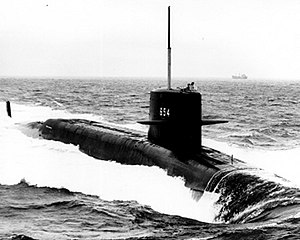
USS Patrick Henry (SSBN-599), named after the American Revolutionary War figure and Founding Father Patrick Henry (1736–1799), was a George Washington class nuclear-powered fleet ballistic missile submarine of the United States Navy. She was later converted into an attack submarine and redesignated SSN-599.

USS Robert E. Lee (SSBN-601), a George Washington-class fleet ballistic missile submarine, was the only ship of the United States Navy to be named for Robert E. Lee (1807–1870), the commanding general of the Confederate forces during the American Civil War.

USS Sam Houston (SSBN-609/SSN-609), an Ethan Allen-class submarine, was the second ship of the United States Navy to be named after Sam Houston (1793–1863), president of the Republic of Texas. Sam Houston was the US Navy's seventh ballistic missile submarine.

USS Lafayette (SSBN-616), the lead ship of her class of ballistic missile submarine, was the third ship of the United States Navy to be named to honor Gilbert du Motier, Marquis de Lafayette, a French military hero who fought alongside and significantly aided the Continental Army during the American Revolutionary War.

USS John Marshall (SSBN-611) was an Ethan Allen-class submarine, the only ship of the United States Navy to be named for John Marshall (1755–1835), the fourth Chief Justice of the United States. Originally a fleet ballistic missile submarine designated SSBN-611, she later was reclassified as an attack submarine and re-designated SSN-611.

USS Will Rogers (SSBN-659) was a Benjamin Franklin-class ballistic missile submarine – the last of the "41 for Freedom" Polaris submarines. She was the only ship of the United States Navy to be named for humorist Will Rogers (1879–1935).

USS Alexander Hamilton (SSBN-617) was a United States Lafayette-class ballistic missile submarine. It was the third ship of the United States Navy to be named for Founding Father Alexander Hamilton, the first US Secretary of the Treasury, who was instrumental in the formation of both the United States Coast Guard and the United States Navy.

USS Simon Bolivar (SSBN-641), a Benjamin Franklin class fleet ballistic missile submarine, was the only ship of the United States Navy to be named for Simón Bolívar (1783–1830), a hero of the independence movements of the former Spanish colonies in South America.

USS George Washington Carver (SSBN-656), a Benjamin Franklin class fleet ballistic missile submarine, was the second ship of the United States Navy to be named for George Washington Carver (1865–1943), an American researcher and inventor.

USS Thomas Jefferson (SSBN-618), an Ethan Allen class nuclear-powered submarine, was the second ship of the United States Navy to be named for Founding Father Thomas Jefferson (1743–1826), the third President of the United States (1801–1809). She later was reclassified as an attack submarine and redesignated SSN-618.

USS John Adams (SSBN-620), a Lafayette-class ballistic missile submarine, was the second ship of the United States Navy to be named for Founding Father John Adams (1735–1826), the second President of the United States (1797–1801), and his son John Quincy Adams (1767–1848), the sixth President of the United States (1825–1829). Both names were used with the captains of the Blue and Gold crews alternately using the names John Adams and John Quincy Adams.

USS James Monroe (SSBN-622), a Lafayette-class ballistic missile submarine, was the only ship of the United States Navy to be named for Founding Father and U.S. president James Monroe. She served with the United States Navy from 1963 to 1990.

USS Woodrow Wilson (SSBN-624), a Lafayette class ballistic missile submarine, was the only ship of the United States Navy to be named for Woodrow Wilson (1856–1924), the 28th President of the United States (1913–1921). She later was converted into an attack submarine and redesignated SSN-624.

USS Henry Clay (SSBN-625), a Lafayette class ballistic missile submarine, was the only ship of the United States Navy to be named for Henry Clay (1777–1852), the American statesman and orator.

USS Kamehameha (SSBN-642) was a Benjamin Franklin-class ballistic missile submarine and the only ship in the United States Navy to be named after Kamehameha I, the first King of Hawaii. She is one of only two United States ships named after a monarch. She was later reclassified as an attack submarine and re-designated SSN-642.

USS Tecumseh (SSBN-628), a James Madison-class ballistic missile submarine, was the fourth ship of the United States Navy to be named for Tecumseh (c.1768–1813), the leader of the Shawnee people.

USS Ulysses S. Grant (SSBN-631), a James Madison-class fleet ballistic missile submarine, was the third ship of the United States Navy to be named for Ulysses S. Grant (1822–1885), American Civil War general and the 18th President of the United States (1869-1877).

USS Casimir Pulaski (SSBN-633), a James Madison-class ballistic missile submarine, was the second ship of the United States Navy to be named for Casimir Pulaski (1745–1779), a Polish general who served in the American Revolutionary War.

USS Von Steuben (SSBN-632), a James Madison-class fleet ballistic missile submarine, was the second ship of the United States Navy to be named for Baron Friedrich Wilhelm von Steuben (1730–1794), a Prussian army officer who served in the American Revolutionary War.

USS Stonewall Jackson, a James Madison-class fleet ballistic missile submarine, was the third ship of the United States Navy to be named for Confederate States Army General Thomas J. "Stonewall" Jackson (1824–1863).




















